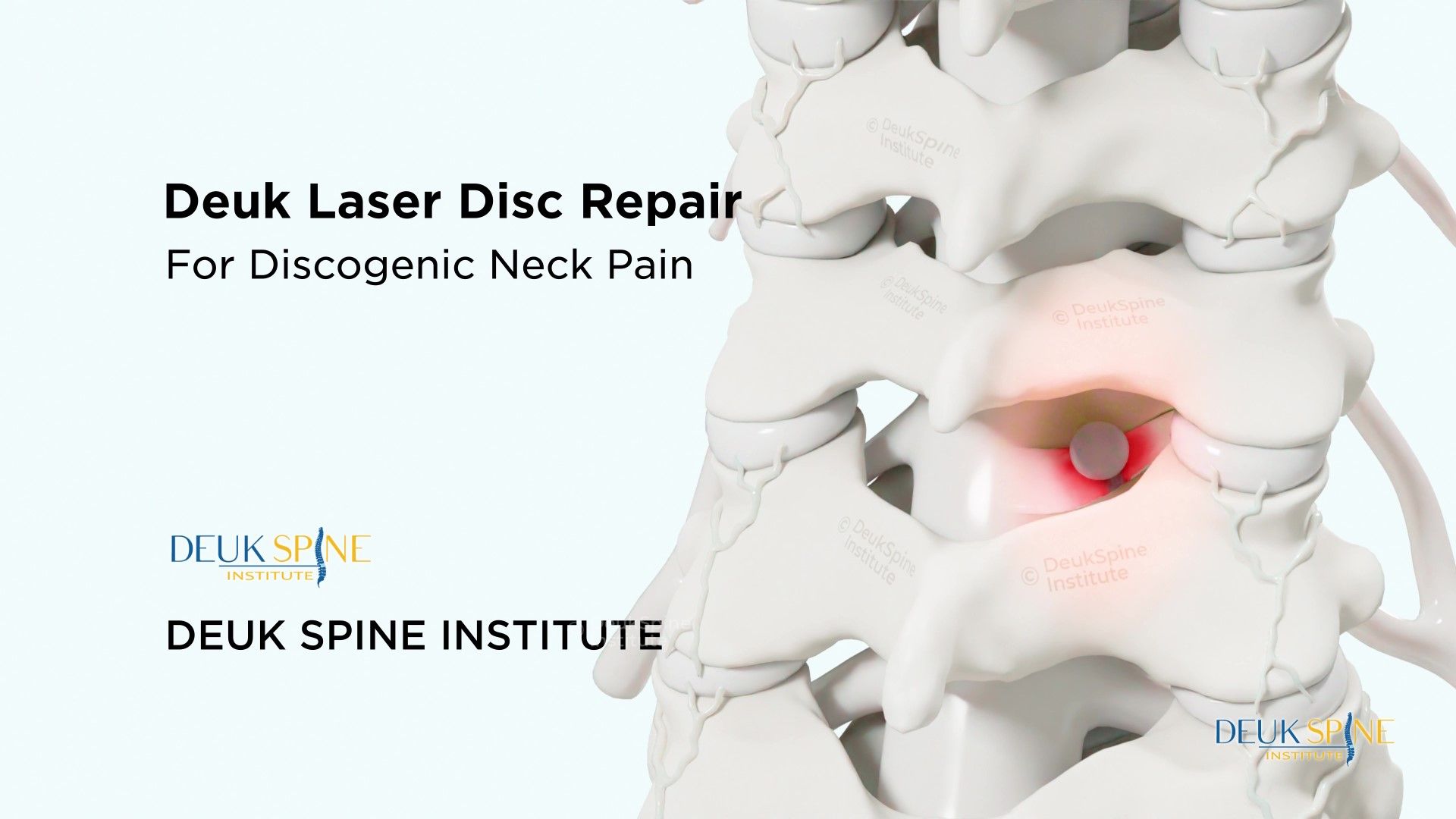Deuk Laser Disc Repair® vs ALL INVASIVE NECK TREATMENTS
If you are suffering from chronic neck pain, headaches, or debilitating pain, numbness, and tingling shooting down your arm—symptoms commonly known as cervical radiculopathy—you know how debilitating it can be. It can control your life, preventing you from working, sleeping, and enjoying time with your family. For too long, patients have been told that their only options for finding a permanent cure are risky, complicated surgeries that carry high rates of failure.
At Deuk Spine Institute, we know patients deserve better. We know that the focus must be on a complete, permanent cure that preserves the integrity of your spine. When facing treatment for a damaged disc in your cervical spine, you have three clear priorities: be free from your symptoms, avoid neck surgery complications, and have the fastest recovery possible.

Deuk Laser Disc Repair (DLDR®), the safest, most effective treatment for neck pain in the world, delivers on all three fronts.
Pinpointing the True Cause of Your Neck Pain
Neck pain has different causes, but it is critical to understand where the problem is most concentrated.
In over 85% of chronic neck pain cases, the source of suffering is a cervical disc herniation. This condition occurs when the soft inner material of the spinal disc (nucleus pulposus) pushes out through a tear in the disc's tough outer wall (annulus fibrosus). This extruded material can compress or irritate the delicate nerve root as it exits the spine, leading to the familiar symptoms of radiating arm pain, numbness, weakness, and persistent chronic neck pain. The herniated material itself can induce the production of potent inflammatory cytokines, creating a chemical "soup" that sensitizes and irritates the surrounding nerve tissue.
Additionally, the spine has facet joints that can also cause pain—a condition known as facet joint disease—this accounts for a far smaller percentage of chronic cases. The disc is the primary culprit, and common treatments fail to permanently remove the inflammatory disc material, leaving patients in permanent pain.

Patient’s Non-Negotiable Priorities
When considering any neck pain treatment for a herniated disc, your goals should be clear. They are the standard against which every surgeon and every procedure should be measured:
- Permanent Symptom Elimination: Your number one priority is complete neck pain relief. You want to be sure the symptoms down your arm, the headaches, and the stiffness will be gone for good, not just a slight chance they will be alleviated.
- Avoidance of Complications: The more invasive the treatment, the higher the risk of complications such as blood clots, infections, nerve injury, and adjacent segment disease. A less invasive procedure is always the superior option for avoiding long-term complications.
- Rapid Recovery: You want to return to a normal life, work, and activities as quickly as possible. Months or years of rehabilitation or reliance on devices and in-home care are unacceptable.
Long-Term Results: The treatment must not create new problems years down the road. You need neck surgery that also preserves motion and structural integrity so you can remain active.
Traditional Neck Fusion: High Risk, Low Reward
ACDF carries a significant risk due to the delicate anatomy of the anterior neck. Complications, including injury to surrounding structures, are common:
- Vascular, Airway, and Neural Risks: There is risk of injury to blood vessels, the trachea, and the esophagus.
- Dysphagia and Hoarseness: Postoperative dysphagia (difficulty swallowing) is frequent, with some prospective studies reporting incidence rates as high as 60%. Other common complications include excessive neck swelling, hoarseness, and infection.
Overall Risk: While complication rates vary widely, studies document significant overall postoperative complication rates, including pseudarthrosis (failure to fuse) and worsening myelopathy.
Low Success Rate for Pain
Despite the high invasiveness, the success rate of ACDF in eliminating neck pain is highly debatable. While it can be successful for arm pain (radiculopathy), relief for persistent axial neck pain is much less certain, often reported between 73% and 83%. This figure is insufficient when compared to a procedure that offers a near-perfect cure. You must demand better than a surgery where one-fifth to one-quarter of patients may still experience persistent neck pain after enduring such an invasive operation.
The Long-Term Catastrophe: Adjacent Segment Disease (ASD)
The fusion process itself is fundamentally flawed. By eliminating motion at the fused segment, the stress of movement is transferred to the discs immediately above and below the fused level. This dramatically accelerates their wear, leading to ASD. This common complication often requires the patient to undergo a second, equally aggressive fusion surgery a few years later.
The Flaws of Other Invasive Alternatives

Artificial Disc Replacement (ADR)
Artificial discs attempt to solve the ASD problem by preserving motion (ACDF vs. artificial disc). However, they introduce a new set of risks while retaining many of the old ones:
- Failure and Migration: ADR involves implanting a mobile disc made of metal and plastic. Complications include disc migration, failure to bind to the bone, or fracture of adjacent vertebrae, particularly in patients with osteoporosis or osteopenia.
- Persistent Symptoms: If the nerve decompression during the surgery is incomplete or the disc alignment is improper, the procedure can fail, resulting in persistent neck pain and cervical radiculopathy.
ASD: While proponents claim better results, meta-analyses show that while the rate of subsequent adjacent-level surgery favoring disc replacement emerges around five years, the risk of ASD and the need for reoperation still exists, proving it is not a perfect solution.
Posterior Cervical Fusion (Laminectomy)
Procedures involving a cervical laminectomy and fusion through the back of the neck also entail a large incision. They are associated with a long list of risks, including nonunion (failure of the bones to fuse), infection, spinal fluid leaks (up to 10% in revision surgeries), and nerve damage. The recovery is often long, painful, and requires months of restriction.
The Opioid Trap
All of these invasive neck surgeries—ACDF, ADR, and posterior fusion—require the postoperative use of narcotic painkillers (opioids). Opioids are dangerous, addictive, and can be abused. Studies have shown that patients taking chronic opioid therapy before cervical fusion surgery have an increased risk of wound complications, infections, and a significantly higher rate of reoperation, including due to adjacent segment disease. You do not want to start this cycle if you can avoid it.

Why Non-Surgical Options Are Not Successful
- Epidural Steroid Injections (ESIs): A treatment often recommended by pain management doctors. ESIs involve injecting steroids to temporarily reduce inflammation. While they may provide relief for days or weeks, the pain always returns because the source of pain (the annular tear and inflammatory material) is never treated. Moreover, the injected steroids are absorbed and cause systemic side effects, including high blood pressure, elevated blood sugar (extremely dangerous for diabetic patients), anxiety, and even HPA-axis suppression. Steroids should be avoided if possible.
- Spinal Cord Stimulators: These are highly invasive devices implanted by untrained doctors who cannot cure your pain. They mask symptoms, cause scar tissue to develop, migrate out of position, and saddle you with a device and a pacemaker for life. Avoid spinal cord stimulators; they do not work as a cure.
Physical Therapy: Physical therapy is fantastic for fitness and mobility, but it will never cure neck pain from a herniated disc.
Discover the Dark Side of the Spinal Fusion Industry
Dr. Deukmedjian exposes scams around artificial disc replacements.
The Safest, Most Effective Neck Pain Cure
Deuk Laser Disc Repair® is the definitive, minimally invasive solution for a herniated, bulging, extruded, ruptured, or degenerated disc in the cervical spine.
This is a state-of-the-art, arthroscopic procedure performed by Dr. Deukmedjian. Using an advanced endoscope and a half-millimeter-wide laser, the surgeon accesses the damaged disc through a tiny incision, avoiding muscle damage. The Deuk Spine Institute offers:
- A Precision Cure: The laser vaporizes and removes the damaged, inflammatory disc material and fragments that are causing the pain. We can see the nerves and spinal cord directly, ensuring an extremely safe treatment.
- Unmatched Success: The DLDR® treatment has the highest success rate of all treatments discussed: a 99% cure rate for neck pain coming from a herniated disc.
- Zero Complications: To date, the Deuk Spine Institute has maintained a record of zero surgical complications with the DLDR® procedure.
- Immediate Recovery: Patients experience immediate relief and are discharged within an hour of the procedure. They often drive themselves in the next morning for a quick checkup, achieving a same-day neck surgery recovery and returning to a normal life without the need for postoperative opioids (non-narcotic neck pain treatment).
If you are seeking minimally invasive neck surgery with recovery time measured in hours, not years, and a permanent cure, Deuk Laser Disc Repair® is your best option. For more information, watch Dr. Deukmedjian explain the differences between DLDR® and other treatments in Deuk Laser Disc Repair® vs ALL INVASIVE NECK TREATMENTS.
The Better Way: Deuk Laser Disc Repair (DLDR)
For patients suffering from debilitating pain or severe instability, the benefits of spinal surgery might seem to outweigh the risks significantly. However, as you can see, they are not procedures without consequences. There is one procedure that has none of these consequences. My revolutionary procedure, Deuk Laser Disc Repair (DLDR), offers a safer way to alleviate neck or back pain without risk of collateral damage, as it avoids the muscles, nerves, ligaments, tendons, and joints.
Upload your latest MRI for a free review and a personal consultation with myself. Ara Deukmedjian, M.D., founder of Deuk Spine Institute and creator of the Deuk Laser Disc Repair® procedure.
